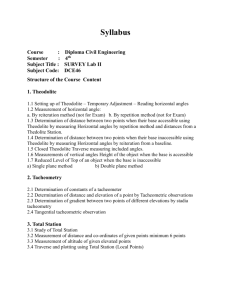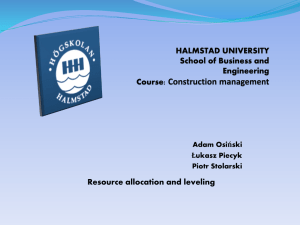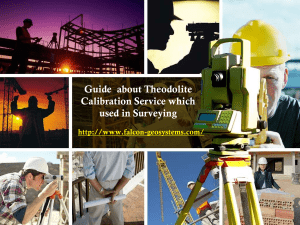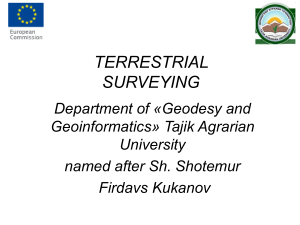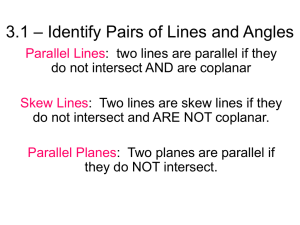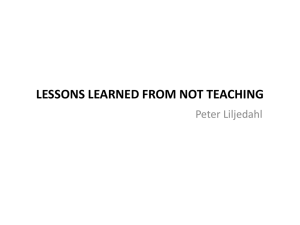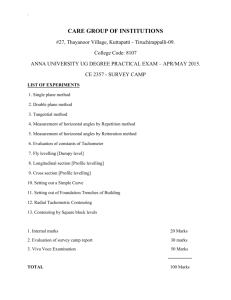SURVEYING - I 1. LEVELLING Definitions of important terms in
advertisement
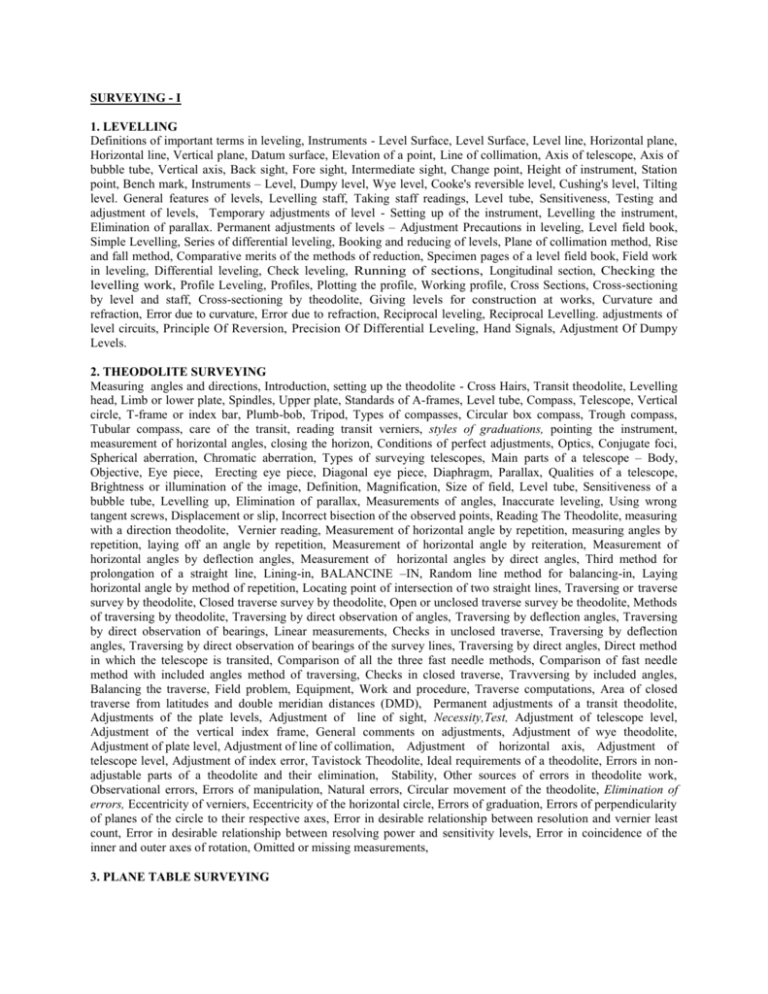
SURVEYING - I 1. LEVELLING Definitions of important terms in leveling, Instruments - Level Surface, Level Surface, Level line, Horizontal plane, Horizontal line, Vertical plane, Datum surface, Elevation of a point, Line of collimation, Axis of telescope, Axis of bubble tube, Vertical axis, Back sight, Fore sight, Intermediate sight, Change point, Height of instrument, Station point, Bench mark, Instruments – Level, Dumpy level, Wye level, Cooke's reversible level, Cushing's level, Tilting level. General features of levels, Levelling staff, Taking staff readings, Level tube, Sensitiveness, Testing and adjustment of levels, Temporary adjustments of level - Setting up of the instrument, Levelling the instrument, Elimination of parallax. Permanent adjustments of levels – Adjustment Precautions in leveling, Level field book, Simple Levelling, Series of differential leveling, Booking and reducing of levels, Plane of collimation method, Rise and fall method, Comparative merits of the methods of reduction, Specimen pages of a level field book, Field work in leveling, Differential leveling, Check leveling, Running of sections, Longitudinal section, Checking the levelling work, Profile Leveling, Profiles, Plotting the profile, Working profile, Cross Sections, Cross-sectioning by level and staff, Cross-sectioning by theodolite, Giving levels for construction at works, Curvature and refraction, Error due to curvature, Error due to refraction, Reciprocal leveling, Reciprocal Levelling. adjustments of level circuits, Principle Of Reversion, Precision Of Differential Leveling, Hand Signals, Adjustment Of Dumpy Levels. 2. THEODOLITE SURVEYING Measuring angles and directions, Introduction, setting up the theodolite - Cross Hairs, Transit theodolite, Levelling head, Limb or lower plate, Spindles, Upper plate, Standards of A-frames, Level tube, Compass, Telescope, Vertical circle, T-frame or index bar, Plumb-bob, Tripod, Types of compasses, Circular box compass, Trough compass, Tubular compass, care of the transit, reading transit verniers, styles of graduations, pointing the instrument, measurement of horizontal angles, closing the horizon, Conditions of perfect adjustments, Optics, Conjugate foci, Spherical aberration, Chromatic aberration, Types of surveying telescopes, Main parts of a telescope – Body, Objective, Eye piece, Erecting eye piece, Diagonal eye piece, Diaphragm, Parallax, Qualities of a telescope, Brightness or illumination of the image, Definition, Magnification, Size of field, Level tube, Sensitiveness of a bubble tube, Levelling up, Elimination of parallax, Measurements of angles, Inaccurate leveling, Using wrong tangent screws, Displacement or slip, Incorrect bisection of the observed points, Reading The Theodolite, measuring with a direction theodolite, Vernier reading, Measurement of horizontal angle by repetition, measuring angles by repetition, laying off an angle by repetition, Measurement of horizontal angle by reiteration, Measurement of horizontal angles by deflection angles, Measurement of horizontal angles by direct angles, Third method for prolongation of a straight line, Lining-in, BALANCINE –IN, Random line method for balancing-in, Laying horizontal angle by method of repetition, Locating point of intersection of two straight lines, Traversing or traverse survey by theodolite, Closed traverse survey by theodolite, Open or unclosed traverse survey be theodolite, Methods of traversing by theodolite, Traversing by direct observation of angles, Traversing by deflection angles, Traversing by direct observation of bearings, Linear measurements, Checks in unclosed traverse, Traversing by deflection angles, Traversing by direct observation of bearings of the survey lines, Traversing by direct angles, Direct method in which the telescope is transited, Comparison of all the three fast needle methods, Comparison of fast needle method with included angles method of traversing, Checks in closed traverse, Travversing by included angles, Balancing the traverse, Field problem, Equipment, Work and procedure, Traverse computations, Area of closed traverse from latitudes and double meridian distances (DMD), Permanent adjustments of a transit theodolite, Adjustments of the plate levels, Adjustment of line of sight, Necessity,Test, Adjustment of telescope level, Adjustment of the vertical index frame, General comments on adjustments, Adjustment of wye theodolite, Adjustment of plate level, Adjustment of line of collimation, Adjustment of horizontal axis, Adjustment of telescope level, Adjustment of index error, Tavistock Theodolite, Ideal requirements of a theodolite, Errors in nonadjustable parts of a theodolite and their elimination, Stability, Other sources of errors in theodolite work, Observational errors, Errors of manipulation, Natural errors, Circular movement of the theodolite, Elimination of errors, Eccentricity of verniers, Eccentricity of the horizontal circle, Errors of graduation, Errors of perpendicularity of planes of the circle to their respective axes, Error in desirable relationship between resolution and vernier least count, Error in desirable relationship between resolving power and sensitivity levels, Error in coincidence of the inner and outer axes of rotation, Omitted or missing measurements, 3. PLANE TABLE SURVEYING Drawing board- Alidade , Accessories, Spirit level, Trough compass or circular box compass, U-frame or plumbing fork, Waterproof cover, Paper, Advantages of plane table survey, Disadvantages of plane table survey, Points to be borne in mind for plane tabling,, Setting up of the table, Levelling, Orientation, Orientation by back sighting, Orientation by magnetic needle, Centring, Testing and adjustments of plane table- Board, Methods of plane table survey, Radiation method of plane tabling, Intersection or triangulation method of plane tabling, Traversing method of plane tabling, Resection method of plane tabling, Three-point problem, Selection of station point S, Solution of three point problem method by trial and error method, Solution of three-point problem by Lehman's rules, Solution of three-point problem by mechanical method, Solution of three-point problem by graphical method, Bessel's method, Two-point problem, Errors in plane tabling, Instrumental errors, Errors of manipulation and sighting, Errors of plotting, Contouring by plane table, Slotted templates, Analytical methods,
